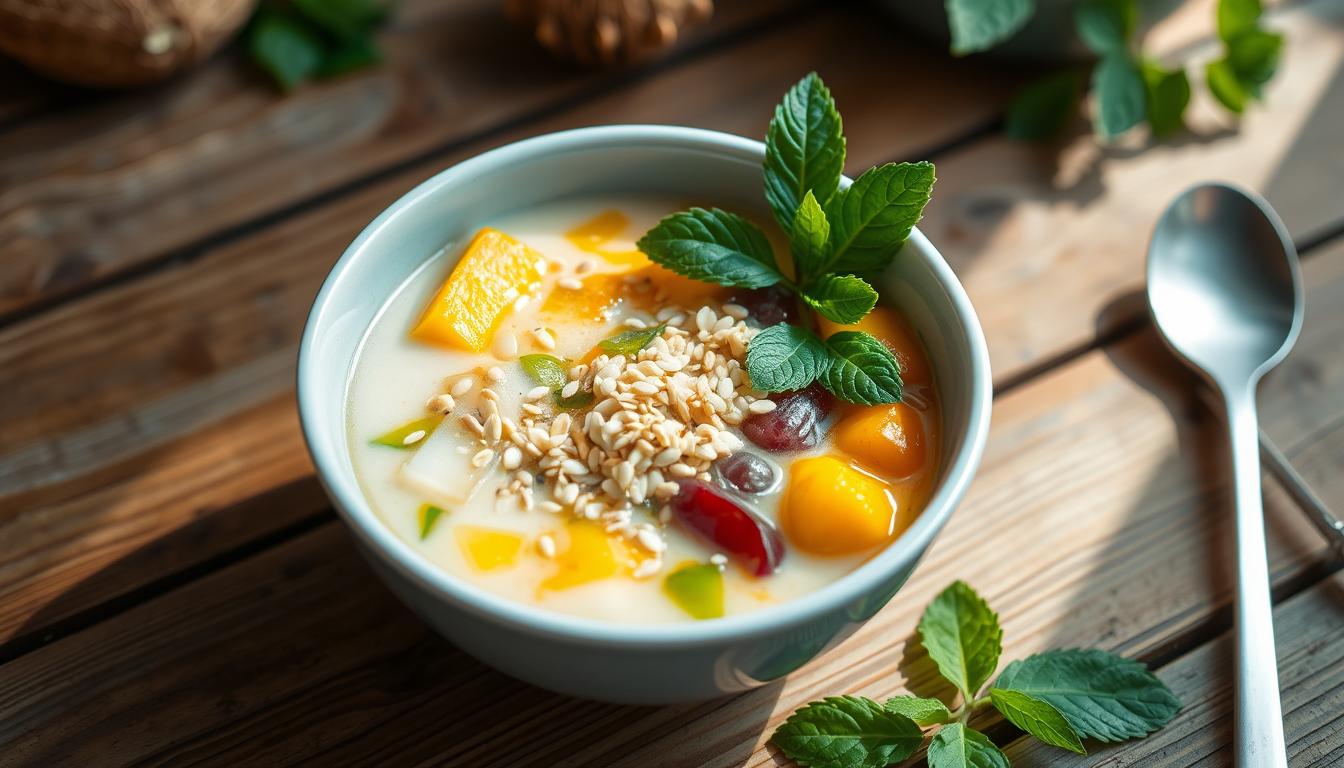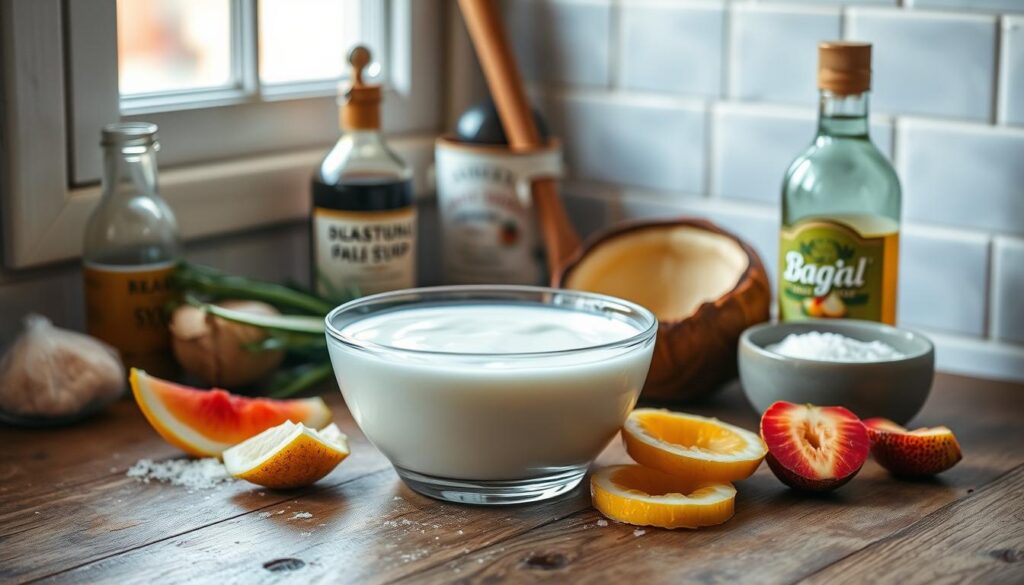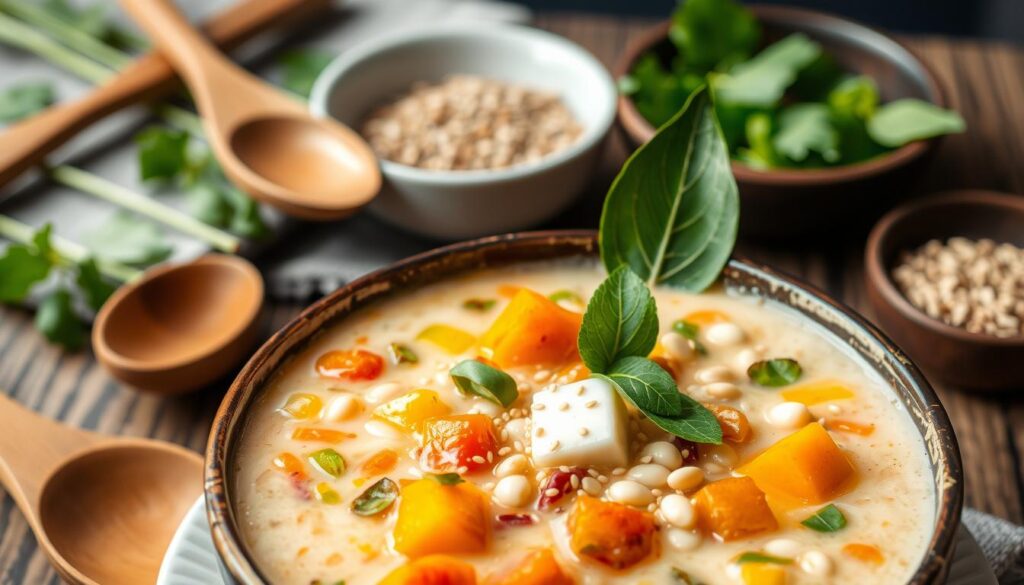As the sun sets, the smell of spices and sweet soup fills the air. Families in Vietnam come together to enjoy a special dessert – the vegan Vietnamese sweet soup, or “chè”. I remember the joy of eating it, with flavors of exotic fruits and creamy textures.
Now, I’m excited to share a vegan version of this dessert. It lets everyone enjoy Vietnamese cuisine. This guide is for both seasoned chefs and curious cooks, leading you to delicious vegan Vietnamese sweet soup desserts. Seeking fresh insights on Vietnamese Che? Check out what we’ve gathered for you!
Table of Contents
Key Takeaways
- Discover the origins and cultural significance of Vietnamese sweet soups (chè)
- Explore plant-based variations and the health benefits of vegan sweet soup recipes
- Master the art of cooking mung beans and incorporating natural sweeteners
- Learn how to create the perfect creamy coconut milk base for your vegan dessert
- Discover creative topping and garnish ideas to elevate your vegan chè experience
Understanding Vietnamese Sweet Soups (Chè)
Vietnamese sweet soups, known as “chè,” are a beloved part of the country’s culinary heritage. These delightful desserts have been enjoyed by people of all ages for generations. They showcase a diverse array of flavors and textures. Traditional vietnamese che recipes often incorporate a variety of ingredients, including beans, fruits, jellies, and the creamy richness of coconut milk.
Origins and Cultural Significance
The origins of vietnamese che can be traced back to Vietnam’s long history of agricultural abundance. This appreciation for the natural world has made these sweet soups an integral part of the country’s cultural identity. They serve as a means to celebrate special occasions, bring families together, and provide a comforting respite from the day-to-day.
Traditional vs. Vegan Variations
While traditional vietnamese che recipes have long been enjoyed, the growing demand for plant-based options has given rise to a range of vegan che recipes. These dairy-free vietnamese puddings maintain the essence of the original dishes. They use innovative, cruelty-free ingredients to cater to a wider audience.
Health Benefits of Plant-Based Sweet Soups
The transition to vegan che has not only expanded the culinary landscape but has also highlighted the health benefits of these plant-based desserts. By using natural sweeteners and nutrient-dense ingredients, such as beans, fruits, and coconut milk, vegan vietnamese puddings offer a wholesome and satisfying treat for health-conscious consumers.
| Nutrition Facts (per serving) | Value |
|---|---|
| Calories | 280 |
| Sugar | 18g |
| Sodium | 50mg |
| Fat | 12g |
| Saturated Fat | 10g |
| Unsaturated Fat | 2g |
| Trans Fat | 0g |
| Carbohydrates | 40g |
| Fiber | 2g |
| Protein | 5g |
| Cholesterol | 0mg |
The evolution of vietnamese che recipes has led to a wide variety of flavors and textures. Whether you prefer the traditional version or a creative vegan che interpretation, these delightful desserts offer a unique and satisfying culinary experience.
Essential Ingredients for Your Vegan Sweet Soup
Making a tasty vegan Vietnamese sweet soup, or chè, needs the right ingredients. At its core are the split mung beans, adding protein, texture, and creaminess. The tapioca pearls add a fun chewy feel.
Coconut milk is key for the dairy-free asian dessert soups taste, making it creamy and rich. Sweeteners like palm or coconut sugar balance the taste. Fragrant pandan leaves or vanilla add a special aroma to the plant-based vietnamese sweets.
Adding fresh fruits like banana, jackfruit, or lychee brings color and flavor. These ingredients blend to make a rich and authentic vegan sweet soup.
| Ingredient | Quantity |
|---|---|
| Split Mung Beans | 1 cup |
| Tapioca Pearls | 1/2 cup |
| Coconut Milk | 2 cups |
| Palm or Coconut Sugar | 1/4 cup |
| Pandan Leaves | 4 leaves |
| Vanilla Extract | 1 teaspoon |
| Fresh Fruit (optional) | 1 cup, chopped |
With these ingredients, you can make your own vegan Vietnamese sweet soup. It’s a modern take on the traditional chè.
Kitchen Tools and Equipment Needed
To make a tasty vegan Vietnamese sweet soup, you need some basic kitchen tools. You’ll also want some special items to make cooking easier and more fun.
Basic Cooking Utensils Required
- A sturdy pot or saucepan for boiling and simmering the ingredients
- A fine-mesh strainer or colander for draining the cooked mung beans
- Measuring cups and spoons to accurately portion out the recipe components
- Wooden or silicone spatulas and spoons for stirring and mixing
- A sharp knife for chopping and slicing any fresh fruits or herbs
Optional Special Equipment
Some extra tools can make making vegan Vietnamese dessert soup easier:
- A blender or food processor for creating a smooth and creamy texture in the coconut milk base
- A slow cooker or Instant Pot to simplify the mung bean cooking process
- A set of serving bowls, coconut shells, or mason jars to beautifully present the final dish
Serving Vessels and Presentation Tools
Choose unique vessels to make your vegan Vietnamese sweet soup look great. Coconut shells, glass jars, or decorative bowls can add elegance. Add fresh herbs, toasted coconut, or coconut milk for extra flair.
With the right tools and equipment, you’ll make a delicious vegan Vietnamese sweet soup. It will impress your guests for sure.
Preparing the Base: Coconut Milk and Natural Sweeteners
Making the perfect plant-based Vietnamese dessert beverages or dairy-free che beverages starts with a rich base. This base is made from coconut milk and natural sweeteners. It’s key to a balanced, indulgent flavor that will make your taste buds happy.
Begin by warming the coconut milk in a saucepan. Stir it often to avoid burning. When it’s warm, add your favorite natural sweetener, like palm sugar or coconut sugar. Keep stirring until the sweetener dissolves, making the base smooth and even.
To add more flavor, you can infuse the coconut milk with pandan leaves or a bit of vanilla extract. These ingredients enhance the natural sweetness and creaminess of the coconut milk. They make the beverage truly special.
After making the base, adjust the sweetness to your liking. Finding the right balance of sweetness is important in Vietnamese desserts. It lets the other flavors stand out. Take your time, taste, and adjust as needed to get the perfect mix.
“The key to a truly exceptional Vietnamese dessert beverage lies in the foundation – a harmonious blend of coconut milk and natural sweeteners that sets the stage for the other flavors to flourish.”
Now that the base is ready, you can start working on mung bean preparations. These are a big part of many traditional Vietnamese sweet soups. Get ready to learn how to cook mung beans just right!
Mastering the Art of Cooking Mung Beans
Preparing mung beans is key to making a great vegan Vietnamese sweet soup dessert. These small green legumes add a sweet taste and creamy texture. Let’s explore how to cook them perfectly.
Soaking and Preparation Methods
Start by soaking the mung beans in water for at least 2 hours, or better, overnight. This makes them softer and easier to digest. After soaking, drain and rinse them well.
Cooking Techniques for Perfect Texture
Now, it’s time to cook the beans. Boil a pot of water, then add the mung beans gently. Simmer for about 30 minutes until they’re tender. For a smoother texture, blend them in a food processor or blender.
Troubleshooting Common Issues
If your mung beans are not cooked right, adjust the cooking time. If they’re undercooked, simmer a bit longer. If they’re too soft, cook them for less time. Watch their texture and adjust as needed.
Learning to cook mung beans well is crucial for a creamy and sweet vegan Vietnamese sweet soup dessert. With these tips, you’ll make a delicious and authentic mung bean dessert that will wow your guests.
Vegan Vietnamese Sweet Soup Dessert Recipe
Try the tasty vegan Vietnamese sweet soup dessert, called Chè. It mixes cooked mung beans and tapioca pearls with coconut milk. This makes a sweet and creamy treat. You can add fresh fruit, nuts, or other toppings for a special touch.
To make the base, simmer coconut milk, natural sweeteners, and flavorings. Then, add cooked mung beans and tapioca pearls. Let it simmer for 5 minutes to blend the flavors.
- Cooked mung beans: Soaked, cooked, and drained mung beans provide a creamy, protein-rich foundation for the dessert.
- Tapioca pearls: Small, chewy tapioca pearls add a delightful contrast in texture to the smooth soup.
- Coconut milk base: A rich and creamy coconut milk base, sweetened with your choice of natural sweeteners, forms the foundation of the dessert.
| Ingredient | Amount |
|---|---|
| Cooked mung beans | 1 cup |
| Tapioca pearls | 1/2 cup |
| Coconut milk | 2 cups |
| Maple syrup | 2 tablespoons |
| Vanilla extract | 1 teaspoon |
Serve the dessert warm or chilled in bowls. Add fresh fruit, toasted nuts, or other toppings. You can make different versions like Chè Chuối (banana and coconut), Chè Ba Màu (three-color dessert), or Chè Bà Ba (taro and sweet potato).
“Chè is a beloved part of Vietnamese culinary heritage, and this vegan version captures the essence of these comforting, nourishing desserts.”
Creative Toppings and Garnishes
Make your vegan Vietnamese sweet soup dessert stand out with creative toppings and garnishes. These add-ons not only look great but also bring different textures and tastes to your dish.
Fresh Fruit Options
Try adding sliced tropical fruits like mango, lychee, or jackfruit. They add a sweet burst of color to your vegan vietnamese sweet soup dessert recipe. These fruits pair well with the creamy coconut milk, making a perfect mix of flavors.
Nuts and Seeds for Crunch
For a nice contrast, top your plant-based vietnamese sweets with toasted coconut flakes, almonds, peanuts, or sesame seeds. These toppings add a crunchy texture and a nutty flavor, making your soup more enjoyable.
Herbal Additions
Fresh mint leaves or basil can add a refreshing touch to your vegan vietnamese sweet soup dessert recipe. They cut through the coconut milk’s richness and add a bright, herbal flavor. These green garnishes also make your dish look appealing.
By using these creative toppings and garnishes, you can turn your vegan Vietnamese sweet soup into a stunning dessert. Try mixing different flavors and textures to create a dish that excites your taste buds.
Serving Temperature Variations and Storage Tips
Vegan Vietnamese sweet soup can be enjoyed in different ways. You can serve it warm for a cozy dessert or chill it for a cool treat on a hot day. This flexibility lets you match the soup to your mood and the weather.
To store leftover vietnamese sweet and sour soup, use an airtight container in the fridge for up to three days. When you want to enjoy it again, warm it gently on the stove. Add a bit of dairy-free vietnamese puddings to get the right consistency. This keeps the soup’s flavors and texture perfect.
For a chilled dessert, make the vietnamese sweet and sour soup ahead and chill it. The cooling will make the flavors pop and offer a nice contrast to the heat. Storing and serving it right ensures the best taste and texture of your vegan Vietnamese sweet soup.
FAQ
What are the key ingredients for vegan Vietnamese sweet soup (chè)?
Vegan Vietnamese sweet soup includes split mung beans and tapioca pearls. It also has coconut milk and natural sweeteners like palm or coconut sugar. You can add flavor with pandan leaves or vanilla. Fresh fruits like banana, jackfruit, or lychee are optional.
What are the essential tools and equipment needed to prepare vegan Vietnamese sweet soup?
You’ll need a sturdy pot for boiling and a fine strainer for mung beans. Measuring cups and spoons are also essential. Optional tools include a blender for smooth textures and serving vessels like coconut shells or mason jars.
How do you prepare the base of the vegan Vietnamese sweet soup?
Start by heating coconut milk with natural sweeteners like palm or coconut sugar. Stir until the sugar dissolves. For extra flavor, add pandan leaves or vanilla extract.
How do you properly cook the mung beans for the perfect texture?
Soak mung beans for at least 2 hours or overnight. Then, boil them for about 30 minutes until tender. For a smoother texture, blend the cooked beans.
How can you customize the vegan Vietnamese sweet soup with different ingredients?
You can make different versions like Chè Chuối (banana and coconut) or Chè Ba Màu (three-color dessert). Try Chè Bà Ba (taro and sweet potato) for another twist.
How should you serve and store the vegan Vietnamese sweet soup?
Serve it warm for a cozy dessert or chilled for a cool treat. Store leftovers in an airtight container in the fridge for up to three days. Reheat gently on the stove, adding coconut milk if it’s too thick.



